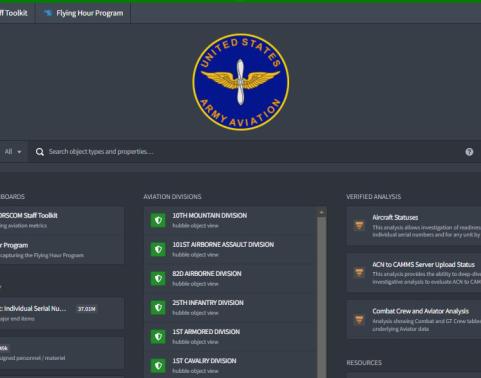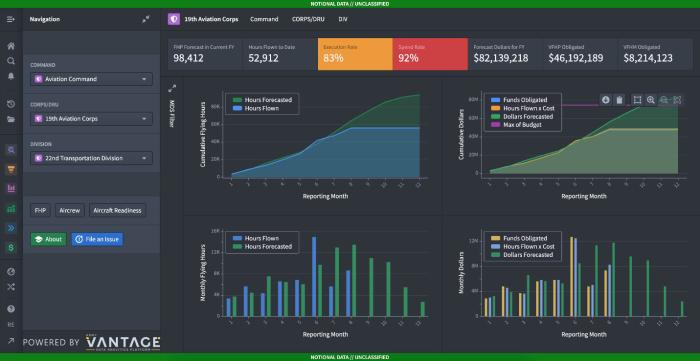Army Vantage Enables Aviation Readiness

Over the past 12 months, Army Vantage and the U.S. Army Forces Command (FORSCOM) have undertaken a project to modernize the command’s aviation readiness reporting and the management of its Flying Hour Program (FHP). As a result, FORSCOM can now leverage several new tools and models to understand and predict unit and individual aviator readiness, and can overlay projections with actual values that update in near-real-time from Army systems of record without human intervention.
Army Vantage helped FORSCOM’s aviation staff think critically about its data holdings and current practices — both those that should continue and those that should end since they were based on less authoritative data.
The Army Vantage ecosystem centralizes existing but previously disconnected data systems, and captures data such as forecasts, which previously only existed in spreadsheets. Through the aviation unit’s collective efforts within Army Vantage, FORSCOM practices are evolving to improve (1) timeliness of data-driven metrics; (2) consistency of the metrics measured and presented; (3) visibility of the metrics at echelon; and (4) visibility into where the data metrics come from.
Enabling Rapid and Reliable Readiness Reporting
Historically, aviation units tracked the number of hours spent in each readiness status on the daily readiness form, DA 1352-1. In parallel, they kept track of the hours in a spreadsheet. At the end of the reporting month, units reported the hand-calculated number of hours spent fully mission capable, not mission capable due to maintenance, and so on. If there were a problem or inquiry with a given metric, the main mechanism that units had at their disposal was a series of phone calls and emails through reporting echelons to track down the origin of a questionable figure.
Today, FORSCOM can leverage Army Vantage to modernize the collection and computation of relevant readiness metrics. Because metrics update frequently as new data becomes available in source systems, this critical function is no longer dependent on a person or series of people pulling and delivering an update. Moreover, defining the logic one time in an enterprise-accessible location like Army Vantage reduces the number of possible entry points for human error. As an example, according to Army regulations, certain aircraft should be excluded from readiness reporting when certain conditions are met. During the rollout phase of the Army Vantage aviation capability, one of the FORSCOM units mistakenly included an aircraft in its spreadsheet of reported readiness, and that negatively impacted readiness rates. Army Vantage, however, correctly excluded the aircraft from the readiness reporting calculations because the rule was defined and consistently applied day-over-day and month-over-month.
Modernizing the Flying Hour Program
Similar to readiness reporting, FORSCOM used to collect unit flight hour projections on a spreadsheet, compute the number of forecast dollars based on the number of forecast hours, and document the number of programmed dollars for funded flying hours. Finding the number of hours that had actually been flown and the number of dollars that had actually been spent introduced opportunities for breaks in consistency. Those metrics were manually pulled and aggregated.
Using Army Vantage, FORSCOM now:
- Manages flying hour projections as a central data asset with a visible history of edits through the front end of Army Vantage
- Computes the projected number of FHP dollars needed based on the forecasted hours
- Automatically aggregates hours from 2408-12 flight records and
- Automatically queries obligated dollars from the General Fund Enterprise Business System (GFEBS).
The process now codified in Army Vantage enables FORSCOM and its reporting units to have a consistent and integrated view to identify issues where projections surpass programmed dollars. It also helps them identify periods when spending for a given Aircraft Mission Design Series or unit challenges the assumptions made based on given cost factors.
Impact and Way Ahead
FORSCOM is now moving from spreadsheet-centric reporting for aviation readiness to pulling metrics from Army enterprise systems in a regular, repeatable and automated fashion. Army Vantage enables FORSCOM to anticipate resource issues and work to resolve them in advance, rather than focusing on collating data that quickly falls out of date. Other organizations are also getting involved in tracking aviation data through the same methodology and data ecosystem. The efforts to modernize aviation readiness reporting and Flying Hour Program management are one step toward focusing FORSCOM’s aviation community on leveraging data and entering it correctly in the first place, which improves visibility and awareness at every level of the Army.
Maj. Beau Carroll, FORSCOM G-37 (Aviation), a significant contributor to the effort, said, “This set of tools gives the FORSCOM team the ability to see discrepancies within authoritative systems that analog reporting methods previously masked.” He added that “in line with the Secretary of the Army’s priority to make the Army data-driven, this capability will get data owners to look at how and what they are reporting — increasing data ownership and quality.”
An Army Vantage account can be requested at vantage.army.mil. To access the aviation data referenced in this article, search for Aviation Workspace in the workflows section of the home page at vantage.army.mil.
Related News
-
Onedia James: a logistician and leader with a family legacy of service
April 22, 2025Onedia James recently stepped into the role of acting deputy project manager for Army Data and Analytics Platforms (ARDAP) at U.S. Army Program Executive Office (PEO) Enterprise, where she helps oversee and support the data portfolio’s four programs. -
ATIS rolls out additional capability, product enhancements to Soldiers
January 14, 2025On Jan. 8, the Army Training Information System (ATIS) team released the latest update to their Army Training Management Capability (ATMC) applications suite. -
Soldier-centered design drives development of ATIS training management software
December 6, 2024U.S. Army Program Executive Office (PEO) Enterprise’s Army Training Information System (ATIS) product office recently completed the first of three software previews, enabling around 700 Soldiers to input data and provide feedback that’s being incorporated into future iterations of the Army’s training management software.
Work for Us
Join a winning team! Search for job opportunities with PEO Enterprise.
Work with Us
Help support important missions. Explore ways your company can work with PEO Enterprise.
